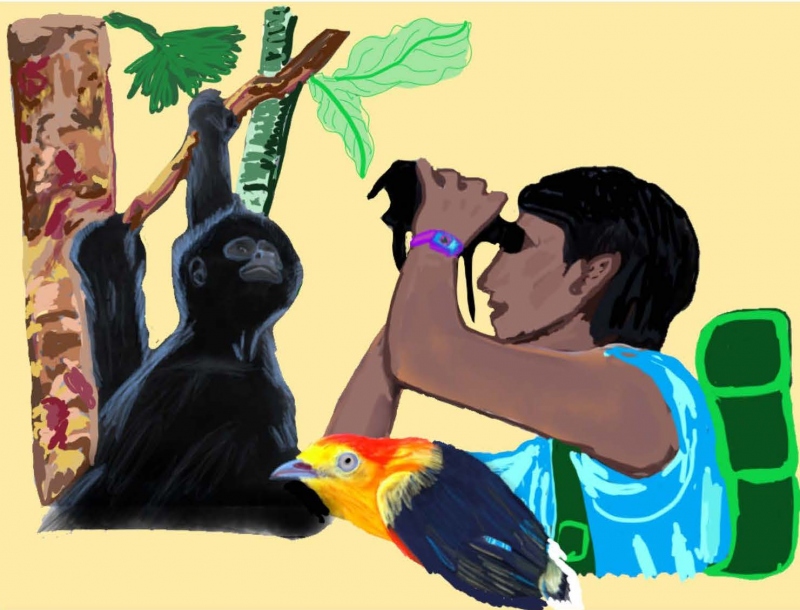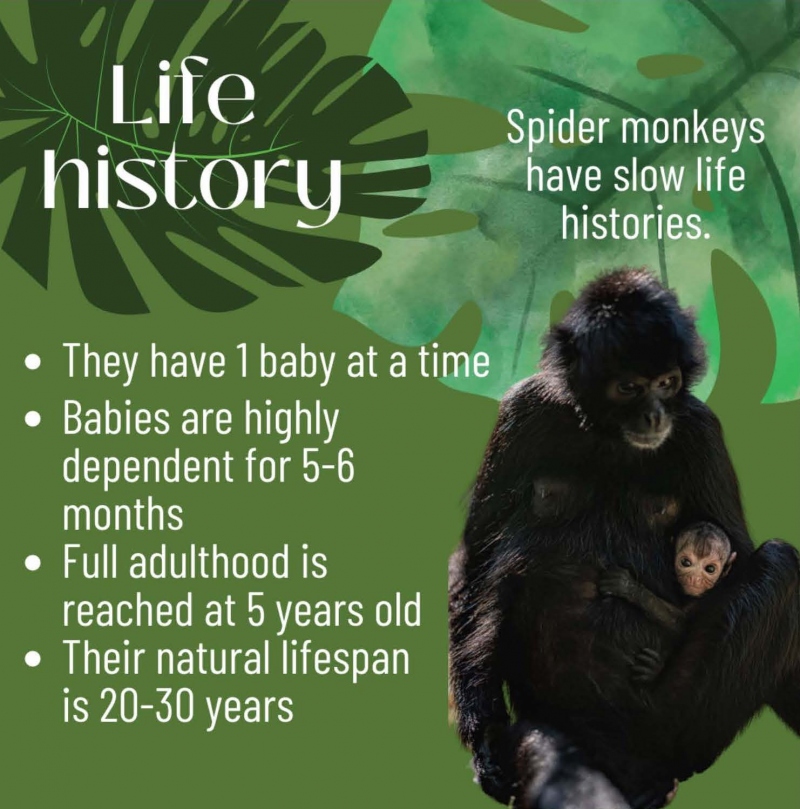Planting Seeds for Conservation of Tropical Forests
April 15, 2022

By Dana Adcock ’22
A spider monkey moves through the canopy of a tropical forest, eating fruit as it goes along. The seeds of the fruit land in the monkey’s stomach. The rough outer layer of the seed is removed by digestive fluid before it proceeds through the digestive track, before eventually landing on the forest floor. This makes spider monkeys particularly powerful seed dispersers.
Fruit-eating primates are often key seed dispersers in tropical forests and promote the biodiversity of the ecosystem. However, this seed dispersal can be impacted by human disturbance of the animals’ habitat.
Forest fragmentation occurs when large, forested areas are broken into smaller patches. Since spider monkeys live in forest canopies, this can limit their movement patterns and therefore their ability to disperse seeds.
Additionally, local community members that interact with spider monkeys are often blamed or ignored in discussions about conservation. This can lead to unrealistic expectations and solutions.

A Bass Connections team is addressing the issue of forest fragmentation in tropical ecosystems, where spider monkeys live, through literature review and science communication. Too many trees are being cleared for development, resulting in fragmented patches that spider monkeys cannot move between. The team is led by Justin Wright, professor of biology, and ecology Ph.D. candidate Anna Nordseth.
Adelmut “Xia” Duffing Romero is a global health master’s student on the team. “Our team consists of [almost] all women across different stages of their careers, who study a diversity of disciplines,” said Romero. “It has been really beautiful to learn how to both care for spider monkeys and do something that will hopefully have a future impact on the health of the rainforest and its people, but also tackle social issues such as how much emotional labor goes into a project or how to tackle imposter syndrome.”
Romero noted that working with Nordseth helped her overcome imposter syndrome in STEM. Nordseth has created a space that is both honest and kind, socially focused and environmentally sound, said Romero.
The team planned to travel to Peru to collect data and use GIS to analyze the data. Since COVID-19 interfered with travel opportunities, the team is pursuing their goals through literature review and science communication. They hope to use existing research and local partnerships to inform the public and promote conservation initiatives.
Combing Papers for Seed Dispersal Clues
The literature review subteam is examining how the traits of animal seed dispersers and seeds impact seed dispersal in response to human disturbance. Each student is tackling a different question, including how body size, flying ability and behavioral characteristics of seed dispersers impact seed dispersal in disturbed habitats. For example, non-flying seed dispersers may have more limited seed dispersal after disturbance of a tropical forest.
Answering these questions will inform how seed dispersal may be limited from forest fragmentation. The team hopes to publish findings to further inform the public.

Collaboration With Community Partners
The other subteam is tackling this issue from a science communication perspective. They are working with community partner Kawsay, a biological station located in the Peruvian Amazon, to develop outreach initiatives. This is a region of the world inhabited by spider monkeys. Team members want to work with the local community to meet their needs and support them in any way they can.
Romero elaborated on working with Kawsay. “Our team collaborates with stakeholders who neither blame nor ignore communities that interact with spider monkeys. This allows us to be a lot more realistic about what works in conservation while allocating resources to local communities. Community-based participatory research and citizenship science are frameworks that center the knowledge and efforts of affected communities, while still engaging in ecological work that supports endangered species.”
Currently, they are developing graphics to raise awareness about local spider monkey populations. Team members have designed mockups of what these graphics might look like. The team hopes Kawsay can utilize these graphics for their social media accounts and to create a deck of playing cards.
A Personal Perspective
As a current team member, I have spent the past year contributing to the literature review. Although I originally hoped to work on geospatial analysis of movement data, complications due to COVID travel restrictions channeled me into this new area. I have enjoyed the opportunity to gain a breadth of knowledge about the field through literature review.
My primary field is marine biology, so exploring terrestrial organisms has been a different but fun foray out of my comfort zone. I have enjoyed the opportunity to learn more about unfamiliar biological ecosystems and hope to apply it to my own studies in the future.
Duke University senior Dana Adcock is a Bass Connections communications assistant who is majoring in Environmental Sciences & Policy.
Learn More
- Read an overview of the team here.
- Browse stories from students.
- Explore the pathways of five alumni who pursued careers in health and medicine.
